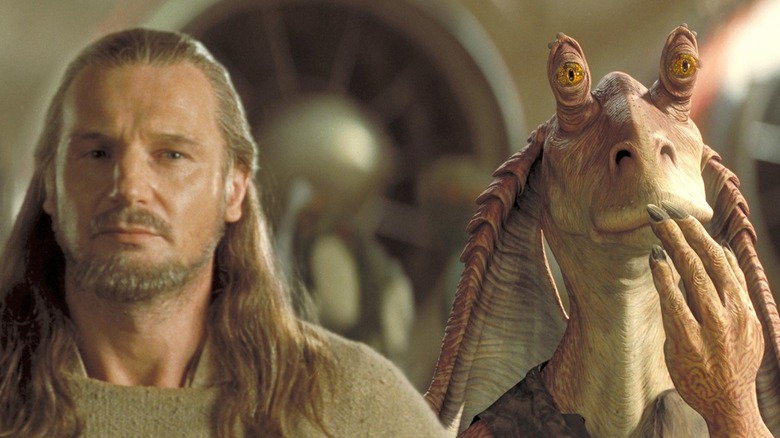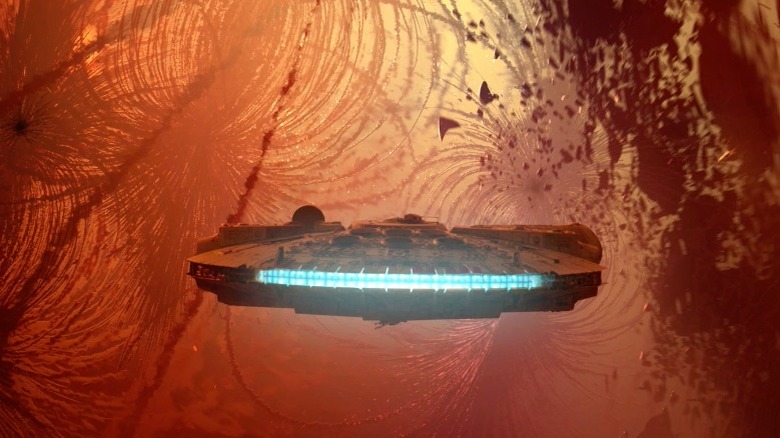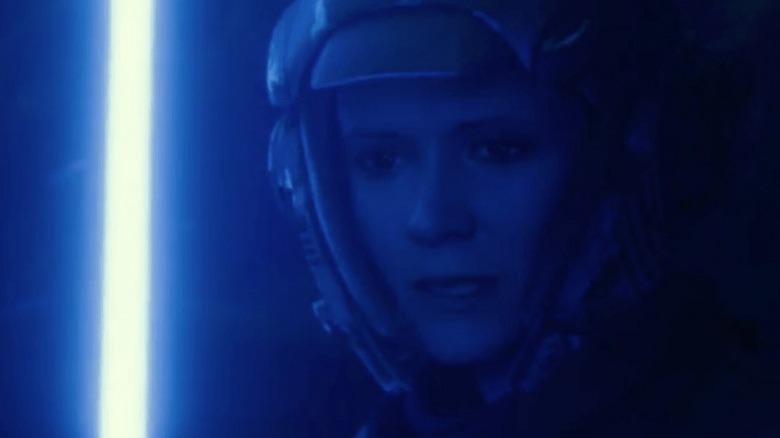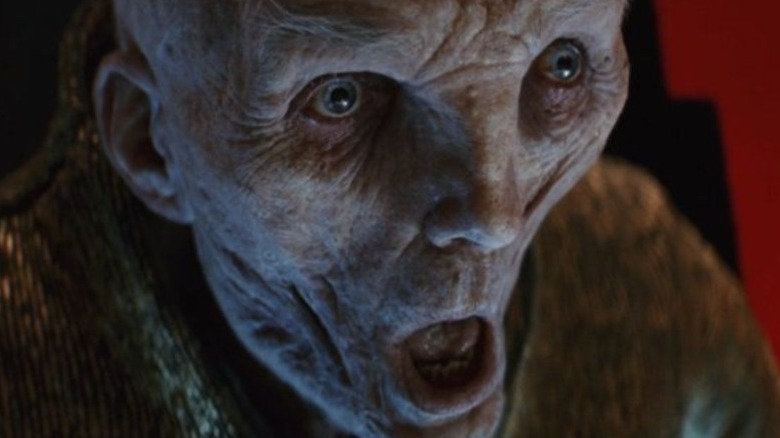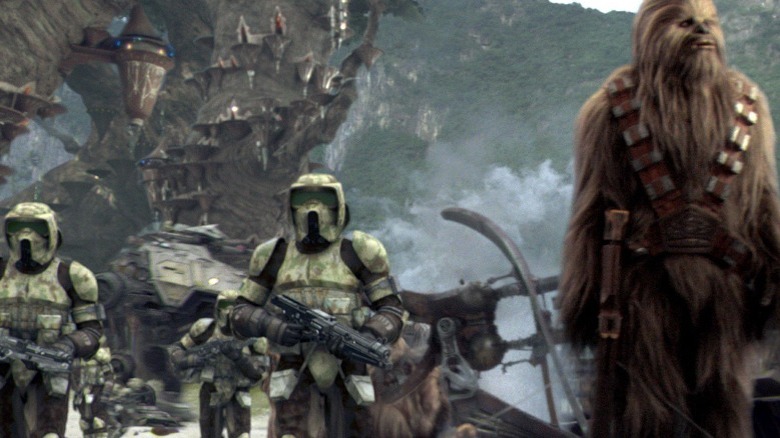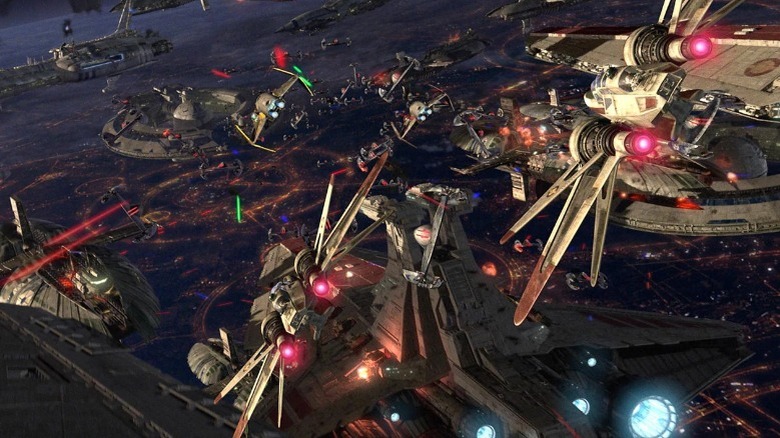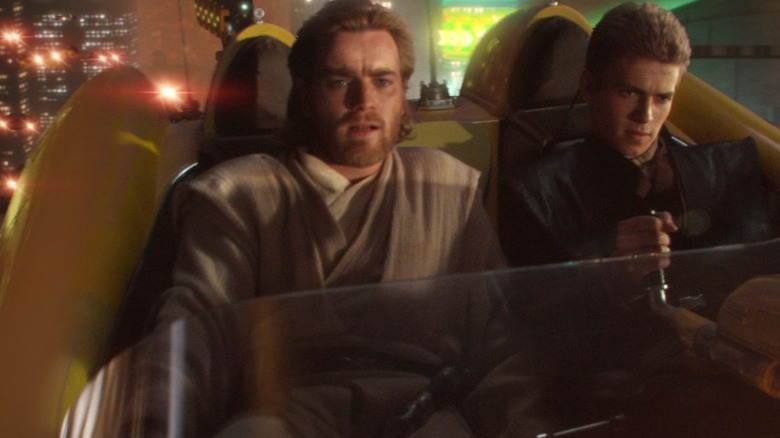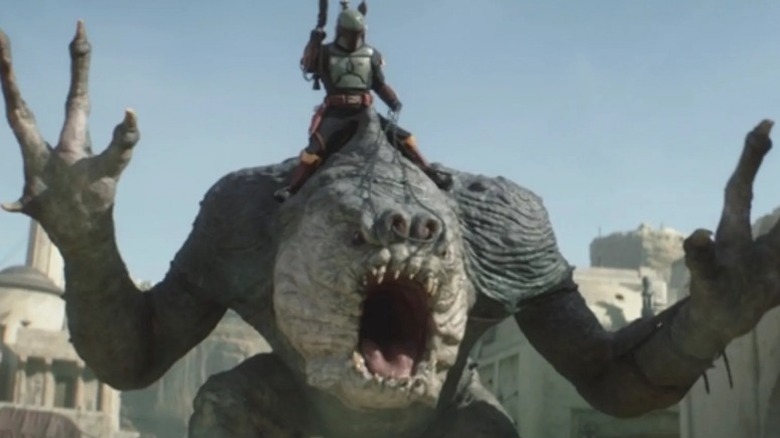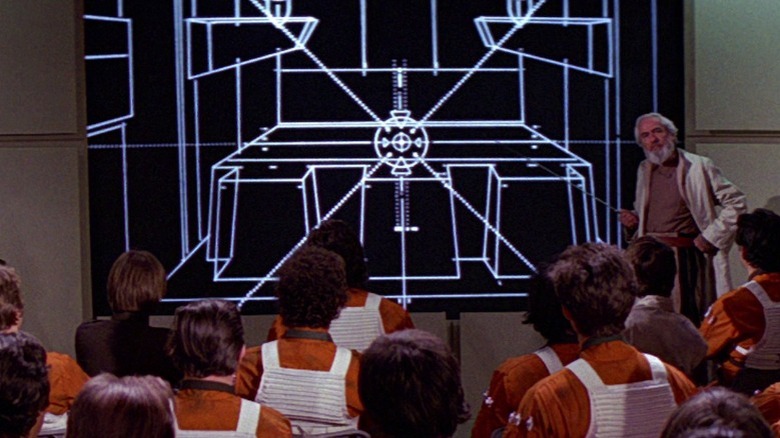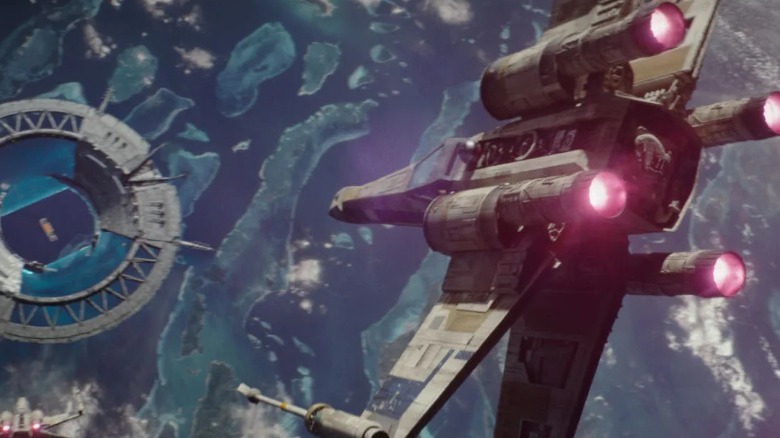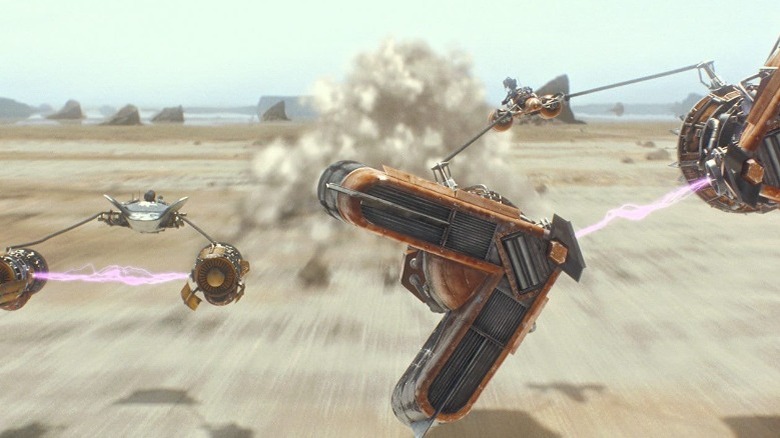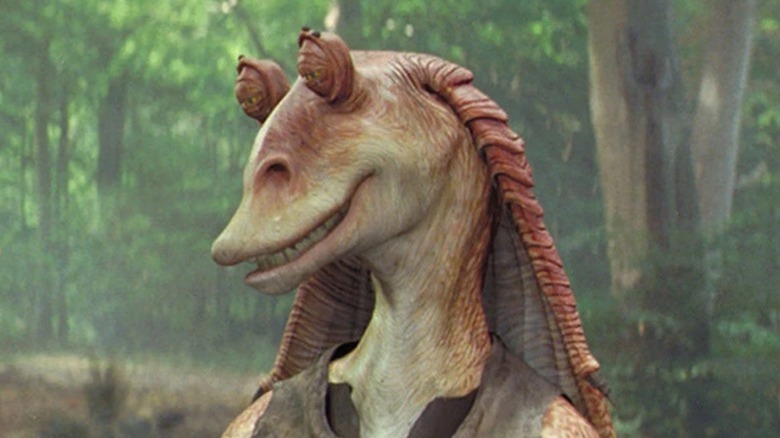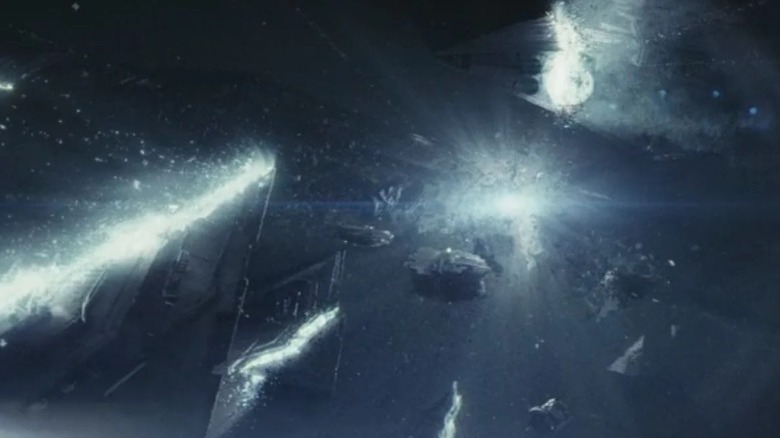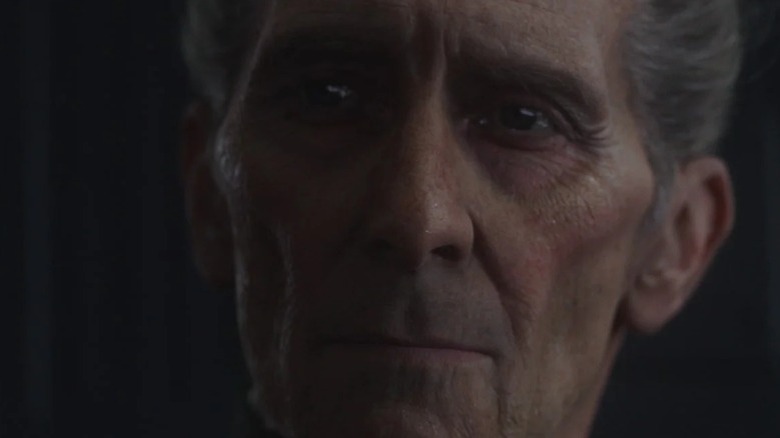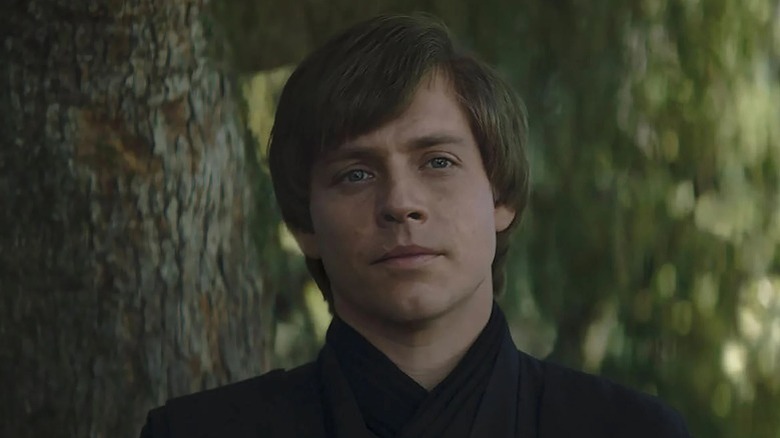The Most Jaw-Dropping CGI Moments In Star Wars History
Aside from its characters and storytelling in a galaxy far, far away, Star Wars is known for breaking boundaries in visual and special effects. The franchise's history with groundbreaking visual storytelling dates back to the original film when writer and director George Lucas created his own special effects company Industrial Light and Magic to produce technology that did not yet exist. ILM has gone on to set the industry standard, creating effects for iconic films like "Jurassic Park" (1993), "Forrest Gump" (1994), and "E.T.: The Extra-Terrestrial" (1982).
While Star Wars is known for utilizing all kinds of practical effects and innovative camera techniques, pushing digital technology forward to create new and breathtaking visual effects is as much a part of Star Wars' legacy as lightsabers, Jedi, or the Force. We've gathered the most jaw-dropping CGI moments in Star Wars history, breaking down what makes them remarkable and groundbreaking for cinema as a whole.
The Kessel Run
"Solo: A Star Wars Story" (2018) faced production issues — original directors Phil Lord and Chris Miller were fired halfway through production and replaced by Ron Howard — but the film still managed to be a fun romp about the young life of Han Solo (Alden Ehrenreich). Though it answered some questions no one asked (like why Han's last name was Solo), the movie also recreated Han's legendary Kessel Run, with Howard and his visual effects team bringing it to life for the first time on the big screen.
The Kessel Run also showcased a massive digital Summa-verminoth monster that threatened to swallow the Millenium Falcon whole. While Star Wars has its share of aliens, the Summa-verminoth monster and its giant eyeball are shocking and memorable within the canon. Thanks to the quality of the CGI and visual effects, the scale of the Lovecraftian monster is incredible to behold, making the threat and subsequent triumph feel all the more real and earned. Through thrilling point-of-view shots of the Falcon and beautiful digitally rendered environments, "Solo" showed audiences just how good of a pilot Han was and why he deserved his own spotlight on the big screen.
Luke and Leia Train
"The Rise of Skywalker" (2019) is bittersweet for many reasons, signaling the end of the Skywalker Saga as well as the last film with General Leia Organa (Carrie Fisher). Fisher had sadly passed away during post-production of the previous film, forcing the filmmakers to determine how to resolve Leia's storyline in a satisfactory way for audiences. As a result, Fisher's appearances in "Skywalker" are almost entirely CGI, but the training sequence is perhaps the most heartfelt.
Though the sequence is brief, the moment is nonetheless groundbreaking both because it reveals Luke had trained Leia as a Jedi, and also because of the CGI accomplishment. With such a vast catalog of archival footage to draw on, the visual effects team used Fisher's own daughter Billie Lourd as a body double then mapped the archival footage onto a digital face, with a similar process used for Mark Hamill's de-aged Luke. Though the final product isn't perfectly accurate, it's still a remarkable and emotional achievement that allowed for a heartfelt sendoff for the legacy character.
Supreme Leader Snoke
After pioneering motion capture technology in the prequel trilogy, the sequel trilogy introduced an all CGI character that served as the keystone antagonist to lead the First Order and Kylo Ren (Adam Driver), mirroring the dynamic of Palpatine and the Empire. Supreme Leader Snoke (Andy Serkis) functioned thematically a bit like the Wizard of Oz, initially appearing on a grander scale through a hologram to Ren and General Hux (Domhnall Gleeson). When Snoke's actual size was revealed in "The Last Jedi" (2017), it was a shock to see he was essentially a withered and weak puppet who was manipulating the First Order to keep a hold on his power.
Utilizing CGI effects to present Snoke physically in a variety of ways, alongside Serkis's performance through the motion capture suit, underscored the storytelling choices to create a mysterious and enigmatic villain. In particular, the computer-generated detail and artistry on Snoke's face lend credibility while adding layers to Serkis's performance, making Snoke an exciting addition to the Star Wars canon as well as a step forward in CGI technology.
Battle of Kashyyyk
CGI works best when it can also complement the world-building and storytelling of the vast Star Wars universe. One of the best examples is the Battle of Kashyyyk in "Revenge of the Sith" (2005). Prior to this, viewers' primary experience with Chewbacca's tree-covered home world was in the notorious and controversial "Star Wars Holiday Special" (1978), which only aired once. Bringing the Wookiee forest planet to life in the midst of the Clone Wars was a challenge in terms of fan expectations as well as an opportunity to showcase a new environment.
The sequence exceeds expectations, however, with dozens of digitally rendered Clone Troopers and Wookiees battling droids in a sweeping sequence that feels alive and unique from other Star Wars battles for its topography and characters. The fight choreography also complements CGI, depicting Wookiees careening from the trees to destroy Separatist droids and forces with grenades. While there are countless battles throughout Star Wars and in "Revenge of the Sith" alone, Kashyyyk is a layered, realistic sequence that stands out.
Battle Over Coruscant
When creating the original trilogy, Lucas was heavily inspired by authentic war films, but his effects teams had difficulties recreating his vision for the space battles due to the limitations of technology. When Lucas returned behind the camera for the prequel trilogy, CGI had advanced to the point that he was able to create the sequences he had always dreamed of, leading to a thrilling opening battle for the prequel trilogy's final film, "Revenge of the Sith" (2005).
While the ships in the original series were primarily constructed and shot using miniature models (limiting the cinematography), the ships in the Coruscant battle sequence were digitally created, giving Lucas more freedom with the camera. This allowed for greater movement to follow our heroes' perspective throughout the battle while also building more scale into the digital environment. The first two minutes are even done as one sustained take. This culmination of Lucas's original vision blends sci-fi epics and World War II aviation films in a way that feels uniquely Star Wars and holds up remarkably well nearly twenty years later.
Coruscant Speeder Chase
While "Attack of the Clones" (2002) is one of the weaker Star Wars films, bogged down by Lucas's political allegories and stiff romantic dialogue, the film contains one of the most exciting opening sequences of any in the franchise. In the style of earlier sci-fi escapade "The Fifth Element" (1997), Lucas uses speeders to lead a chase throughout the city. The action is brilliantly paced, the CGI allowing for first-person perspective shots of the speeders as they plummet through Coruscant's literal skyscrapers.
The sequence is also successful for its detailed and unique world-building, creating a colorful city landscape rarely seen in Star Wars. Outside of that immediate environment, the sequence also has incredible CGI in its supporting characters. As Anakin (Hayden Christiansen) and Obi-Wan (Ewan McGregor) chase a bounty hunter (who is eventually killed by an invisible assailant), further digital effects reveal her to be a changeling, with her face transforming from human to alien in real-time as she dies. The CGI perfectly underscores the storytelling and is an example of Star Wars' visual effects at their best.
The Baby Rancor
As Star Wars expands into live-action television, there are plenty of opportunities to incorporate characters and settings across stories. "The Book of Boba Fett" (2021) achieved this to great effect by introducing the cuddliest of monsters, the baby rancor, a gift to the gangster. While the rancor initially appeared as a terrifying monster in Jabba's palace in "Return of the Jedi" (1981), Boba's (Temuera Morrison) rancor was a youngling of its species that he eventually learns to ride.
Visually, the baby rancor also signified the magical brand of Star Wars effects, a combination of a gigantic practical puppet and CGI. While the rancor's head and shoulders were built out as a puppet, allowing for intricate characterization, the rancor's arms were digitally animated. In the final episode of the series, when Boba rides the rancor atop buildings in Mos Espa, the rancor is entirely digitally animated, creating an impressive action scene harkening back to "King Kong." Additionally, because the finale was outdoors on location, and not in the volume as the vast majority of the rest of the series was, the control and final product of the CGI rancor are all the more impressive.
The Death Star Plans
While the original trilogy primarily utilized practical effects and camera techniques to achieve the iconic space battles the saga would become known for, Lucas and ILM also incorporated some limited CGI that was some of the first-ever seen in cinema. Towards the end of the film, a pivotal scene with the Rebels reveals there are blueprints they can utilize to destroy the Death Star. During the sequence, a rudimentary animation displays the corridor Luke and the rebel pilots will have to navigate to accomplish the mission.
The black and white maze-like animatic is in fact some of the first computer-generated imagery in film, created by a group of animators at the University of Illinois at Chicago. While it was brief and seems dated in retrospect, the animation was a landmark achievement for the era. Of course, Lucas recognized the need to further push CGI technology forward, later creating the division of Lucasfilm that would spin off into Pixar.
Battle of Scarif
"Rogue One" (2016) is not only a remarkable standalone story, it has some of the most breathtaking special effects of the entire Star Wars saga. As a prequel, "Rogue One" perfectly tees up "A New Hope" (1977) in terms of story and style, while maintaining its own identity. The battle of Scarif is perhaps the perfect example of this, an epic war between the Rebels and Empire on the scale Lucas would have wanted for his original film but was unable to accomplish technically.
With the gift of CGI and ILM's virtual camera system, every X-wing, star, and planet is fully realized in immaculate, breathtaking detail. "Rogue One" also doesn't shy away from the brutality of war, utilizing digital imagery to showcase ships crashing into shields along with the brutal destruction of the Empire's base. The sequence also delivers what is perhaps the most memorable scene from the film, the victims' perspective of a fatal Death Star blast that is altogether chilling, a visual effect that would not have been the same with a matte painting. Director Gareth Edwards edited unused footage from the original film into his own, which makes the battle feel all the more authentic.
Boonta Eve Podracing
The prequels may be controversial within the fandom, but Lucas nonetheless used his return to the director's chair with complete creative control to continue to push CGI technology forward. Perhaps the most memorable example of Lucas's innovation is the podracing sequence from "The Phantom Menace" (1999), a twist on the classic car chase that is a visual feast for the eyes. While many assume the scene is entirely CGI, the arena is actually constructed of numerous miniatures, another classic Star Wars blend of classic and modern filmmaking.
As a result, the sequence combines practical effects and live-action while employing CGI to create a thrilling podrace. With animated thrusters on the vehicles, the propulsion and tension in the race come to life. Beyond the digital imagery required to produce the race itself, the sequence also includes multiple 100% digital characters, such as Anakin's primary opponent Sebulba, Jar Jar Binks, and a digitally animated Jabba the Hutt, who first appeared as a puppet in the original trilogy.
Jar Jar Binks
While CGI characters are now standard throughout the film industry (not just in Star Wars), Jar Jar Binks was the first movie character to be fully realized through motion capture technology as well as the first fully CGI supporting character in a film. Introduced in "The Phantom Menace" (1999), the silly Gungan alien was inspired by Goofy and targeted toward young Star Wars fans.
Actor Ahmed Best's brought Jar Jar to life through his physical performance by wearing a prosthetic suit that visual effects artists animated the digital character on top of, creating the character fans loved to hate while pioneering motion capture technology. Through both Best's performance and the incredible animation, Jar Jar is impressively fluid, lifelike, and slapstick, achieving a visual character that holds up remarkably well more than twenty years later. Regardless of how the character was received in the fandom, Best, ILM, and Jar Jar paved the way for iconic CGI characters like Gollum.
The Holdo Maneuver
"The Last Jedi" (2017) may have received mixed reviews from fans, but writer-director Rian Johnson undeniably contributed beautiful visual imagery to his Star Wars film. One of the main storylines in the film involves the First Order pursuing the Resistance as they try to outrun General Hux and Kylo Ren. However, when they begin to run out of fuel, they resort to a heartbreaking backup plan with General Holdo (Laura Dern) sending the fledgling remains of the Resistance on escape shuttles so she can stay behind as a decoy in a heroic moment of self-sacrifice.
Though it's a brief moment, the visual effects of the Holdo maneuver destroying Snoke's warship in perfect silence are stunning, a silent ten-second scene with jump cuts of exploding ships that uses digital imagery to stunning effect. It's a breathtaking, wholly original moment that shocked audiences to the extent it led some theaters to post warnings outside of screenings.
The Resurrection of Tarkin
Because of its positioning in the Star Wars timeline, it made sense for "Rogue One" (2016) to resurrect the villainous Grand Moff Tarkin for the big screen. Peter Cushing — the actor who originally portrayed Tarkin — sadly passed away in 1994, leaving director Gareth Edwards with the option to either recast the role with a different actor or use technology to bring the character back to life.
The result is a digital recreation of Tarkin with body double Guy Henry performing the role in a motion capture suit with visual effects artists using archival footage to animate Cushing's face on top of Henry's. CGI Tarkin is an advanced and truly mind-blowing iteration of the character animation technology ILM pioneered for "The Phantom Menace" (1997). While the final result isn't completely accurate or realistic, it is an incredible rendering as well as an homage to an iconic character in the Star Wars universe, underscoring the leaps and bounds CGI has taken in the two decades since Jar Jar Binks's first appearance.
Return of Young Luke
With no Star Wars film on the big screen since "The Rise of Skywalker" in 2019, it makes sense that Star Wars' biggest technological innovations in recent history would happen on the small screen. Like Tarkin's resurrection in "Rogue One" (2016), a young Luke Skywalker returned to the small screen through the power of CGI. Because "The Mandalorian" takes place in the era after "Return of the Jedi" (1983), "The Mandalorian" creative team was tasked with bringing the character back to life in that same time period for the shocking second season finale.
Similar to the method utilized in "Rogue One," both original actor Mark Hamill, and a younger body double (Max Lloyd-Jones), filmed Luke's scenes. The visual effects artists then used deepfake technology to compile archival footage into a composite performance to animate a young Luke's face on top of the actors'. Additionally, they used machine learning and recordings of Hamill to create young Luke's voice. The technology itself made leaps and bounds between Luke's initial appearance in "The Mandalorian" and his return in "The Book of Boba Fett," with the CGI face looking that much more realistic, an amazing and simultaneously worrying feat of technology.
